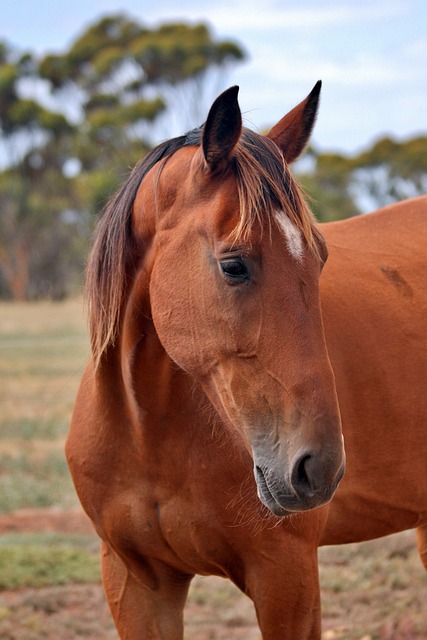Equine strongyle control using selective anthelmintic treatments: Observations in a horse farm from Córdoba, Argentina
Observaciones en un establecimiento de Córdoba, Argentina
DOI:
https://doi.org/10.14409/favecv.2024.23.e0034Keywords:
selective treatment, nematodes, equine, ArgentinaAbstract
The small strongyles are the most prevalent and important parasites in equines worldwide, and the widespread development of antihelmintic resistance is driving the application of selective treatments (ST) in young and adult equines to decrease or delay the development of these phenomena. This strategy is based on nematode egg counts per gram of feces (epg) from all members of the animal group to treat only those that exceed a certain threshold or cutoff point (CP) in egg count. In this context, the objective of this study was to report the results obtained in the application of ST for the control of equine strongyles on a farm in the province of Córdoba during a two-year period and to present an economic analysis comparing the cost of ST versus the usual practice of deworming all animals at fixed intervals. In both cases, a commercial paste formulation for equines containing moxidectin + oxfendazole + praziquantel was used. The results showed that only 20% of the equines required treatment each season of the year (CP=300 epg), which implied a large number of animals that did not have contact with anthelmintic drugs, a practice that favors parasite refuge.The results of two years of selective treatments (ST) application showed that only 20% of the equines required treatment in each season of the year (cut-off=300 epg), indicating a large number of animals that did not have contact with anthelmintic drugs, a practice that promotes parasite refuge. Additionally, it was observed that no equine needed more than two treatments per year, suggesting the possibility of reducing the sampling frequency for ST. However, it must be associated with an annual mass prophylactic treatment for the control of large strongyles and tapeworms. Economic analysis revealed that ST represented a 54% savings compared to mass deworming at fixed intervals, with anthelmintics being the highest costs among all analyzed. In conclusion, this study demonstrates the technical feasibility and economic advantages of ST for strongyle control in equines. These programs can prolong the lifespan of anthelmintics and reduce costs in the context of sustainable parasite control. However, the need for education and extension is emphasized for successful implementation of these programs as an essential step towards evidence-based veterinary medicine.
References
Abbas G, Ghafar A, Hurley J, Bauquier J, Beasley A, Wilkes EJA, Jacobson C, El-Hage C, Cudmore L, Carrigan P, Tennent-Brown B, Gauci CG, Nielsen M K, Hughes KJ, Beveridge I, Jabbar A. 2021. Cyathostomin resistance to moxidectin and combinations of anthelmintics in Australian horses. Parasites Vectors 14:597. DOI: 10.1186/s13071-021-05103-8.
Alm YH, Osterman-Lind E, Martin F, Lindfors R, Roepstorff N, Hedenström U, Fredriksson I, Halvarsson P, Tydén E. 2023. Retained efficacy of ivermectin against cyathostomins in Swedish horse establishments practicing selective anthelmintic treatment. Vet. Parasitol. 322: 110007. DOI: 10.1016/j.vetpar.2023.110007.
Anziani OS, Muchiut S, Cooper LG, Cerutti J. 2016. Small strongyles (cyathostomes) and benzimidazoles. Persistance of status of resistance after nine years without the use of these drugs and efficacy of ivermectin about this parasite population. J. Equine Vet. Sci. 39: 52-53. DOI: 10.1016/j.jevs.2016.02.115
Anziani OS, Cooper LG, Cerutti J, Caffe, G. 2017. Informe Técnico para SENASA (Sevicios a Terceros de la UCC) Informe final sobre: Eficacia de una formulación oral de moxidectina, praziquantel y oxfendazol en el control de los helmintos intestinales (nematodes y cestodes) de mayor prevalencia en los equinos de la Argentina. Pp. 1-12.
Anziani OS, Ardusso G. 2017. Resistencia a los antihelmínticos en nematodes intestinales que parasitan a los equinos en la Argentina. RIA. 43: 1-12.
Becher AM., van Doorn DC, Pfister K, Kaplan RM, Reist M, Nielsen MK. 2018. Equine parasite control and the role of national legislation - A multinational questionnaire survey. Vet. Parasitol. 259: 6-12. DOI: 10.1016/j.vetpar.2018.07.001.
Brady, HA, Wade TN. 2009. Drug Resistance in Equine Parasites: An Emerging Global Problem. J. Equine Vet. Sci. 29: 285-295. DOI: 10.1016/j.jevs.2009.04.186
Bull KE, Allen KJ, Hodgkinson JE, Peachey LE. 2023. The first report of macrocyclic lactone resistant cyathostomins in the UK. Int. J. Parasitol.: Drugs Drug Resist. 21: 125-130. DOI: 10.1016/j.ijpddr.2023.03.001.
Cerutti J, Cooper LG, Caffe G, Cervilla N, Muchiut S, Anziani OS. 2012. Resistencia de los pequeños estrongílidos (grupo ciatostoma) a los bencimidazoles en equinos del área central de Argentina. Rev. InVet. 14: 41-46. En: http://www.scielo.org.ar/scielo.php?script=sci_arttext&pid=S1668-34982012000100005&lng=es&tlng=es.
Cooper LG, Paz Benard BJ, Molineri A, Caffe G, Fernández Llanos I, Fassola L, Cerutti J, Anziani OS. 2020. Eliminación de huevos de los pequeños estróngilos en la materia fecal de los equinos y su importancia práctica en la posibilidad de tratamientos selectivos. FAVE Sección Ciencias Veterinarias 19: 1-6. DOI: 10.14409/favecv.v19i1.8977.
Cooper LG, Paz Benard BJ, Nielsen MK, Molineri A, Anziani OS. 2021. A survey of helminth control practices on large horse farms in Argentina. Equine Vet. J. 53: 50-50. DOI: 10.14409/favecv.2023.22.e0012.
Cooper LG, Paz Benard BJ, Caffe G, Fernández Llanos I, Anziani OS. 2022. Evaluaciones sobre la eficacia clínica de la ivermectina en el control de los pequeños estróngilos equinos (Cyathostoma spp). Status de susceptibilidad o resistencia en establecimientos del área central de la Argentina. FAVE Sección Ciencias Veterinarias 22: 1-17. DOI: 10.14409/favecv.2023.22.e0012.
Cooper LG, Paz Benard BJ, Caffe G, Fernández Llanos I, Arroyo FJ, Anziani OS. 2023. Estudios sobre la eficacia del pirantel para el control de los pequeños estróngilos en equinos del área central de la Argentina. FAVE Sección Ciencias Veterinarias 22: e0024. DOI: 10.14409/favecv.2023.22.e0024.
Cooper LG, Paz Benard BJ, Nielsen MK, Caffe G, Arroyo FJ, Anziani OS. 2024. First report of ivermectin resistance in cyathostomins (small strongyles) of horses in Argentina. Vet. Parasitol.: Reg. Stud. Rep. 52 : 101046. DOI: 10.1016/j.vprsr.2024.101046.
ESCCAP. 2019. Guide to the Treatment and Control of Equine Gastrointestinal Parasite Infections 8. 1-32.
Geurden T, van Doorn DC, Claerebout E, Kooyman F, De Keersmaecker S, Vercruysse J, Besognet B, Vanimisetti B, di Regalbono AF, Beraldo P, Di Cesare A, Traversa D. 2014. Decreased strongyle egg re-appearance period after treatment with ivermectin and moxidectin in horses in Belgium, Italy and The Netherlands. Vet. Parasitol. 204: 291-296. DOI: 10.1016/j.vetpar.2014.04.013.
Gómez- Cabrera K, Salas- Romero J, Sifontes JA, De la Torre Cánova R, Salas JE, Nielsen MK. 2021. Feasibility of selective anthelmintic therapy to horses in tropical conditions: the Cuban scenario. Trop. Anim. Health Prod. 53: 545. DOI: 10.1007/s11250-021-02966-y.
Halvarsson P, Grandi G, Hägglund S, Höglund J. 2023. Gastrointestinal parasite community structure in horses after the introduction of selective anthelmintic treatment strategies. Vet. Parasitol. 326:110111. DOI: 10.1016/j.vetpar.2023.110111.
Kaplan RM, Klei T, Lyons E, Lester G, Courtney C, French D, Tolliver S, Vidyashankar A, Zhao Y. 2004. Prevalence of anthelmintic resistant cyathostomes on horse farms. JAVMA. 225: 903-911. DOI: 10.2460/javma.2004.225.903.
Kaplan RM, Nielsen MK. 2010. An evidence-based approach to equine parasite control: It ain’t the 60s anymore. Equine Vet. Ed. 22: 306-313. DOI: 10.1111/j.2042-3292.2010.00084.x
Kaplan, R.M., Denwood, M.J., Nielsen, M.K., Thamsborg, S.M., Torgerson, P.R., Gilleard, J.S., Dobson, R.J., Vercruysse, J., Levecke, B., 2023. World Association for the Advancement of Veterinary Parasitology (W.A.A.V.P.) Guideline for diagnosing anthelmintic resistance using the faecal egg count reduction test in ruminants, horses and swine. Vet. Parasitol. 318:109936. DOI: 10.1016/j. vetpar.2023.109936.
Lawson AL, Malalana F, Mair TS. 2023. Larval cyathostominosis: Clinicopathological data and treatment outcomes of 38 hospitalised horses (2009-2020). Equine Vet. Educ. 35: 424-435. DOI: 10.1111/eve.13782
Lester HE, Spanton J, Stratford CH, Bartley DJ, Morgan ER, Hodgkinson JE, Coumbe K, Mair T, Swan B, Lemon G, Cookson R, Matthews JB. 2013. Anthelmintic efficacy against cyathostomins in horses in Southern England. Vet. Parasitol. 197: 189-196. DOI: 10.1016/j.vetpar.2013.06.009.
Losinno SJ, Aguilar J, Carbonetti L, Ferniot E, San Esteban F, Flores Suares CM. 2018. A survey on parasite control in sport horses of Argentina and other regional countries. Vet. Parasitol. Reg. Stu. Rep. 13: 74-78. DOI: 10.1016/j.vprsr.2018.01.004.
Love S, Murphy D, Mellor D. 1999. Pathogenicity of cyathostome infection. Vet. Parasitol. 85: 113-121. DOI: 10.1016/S0304-4017(99)00092-8.
Matthee S, Mcgeoch MA. 2004. Helminths in horses: use of selective treatment for the control of strongyles. Jl S. Afr. Vet. Ass. 75: 129-136. DOI: 10.4102/jsava.v75i3.468.
Nielsen MK, Pfister K, Von Samson-Himmelstjerna G. 2014a. Selective therapy in equine parasite control-Application and limitations. Vet. Parasitol. 202: 95-103. DOI: 10.1016/j.vetpar.2014.03.020.
Nielsen MK, Reist M, Kaplan RM, Pfister K, van Doorn DC, Becher A. 2014b. Equine parasite control under prescription-only conditions in Denmark - Awareness, knowledge, perception, and strategies applied. Vet. Parasitol. 204: 64-72. DOI: 10.1016/j.vetpar.2013.10.016.
Nielsen, MK, Reinemeyer CR. 2018. Pathology of Parasitism and Impact on Performance. Handbook of equine parasite control. Wiley-Blackwell, Hoboken, p. 284. DOI: 10.1002/9781119382829.
Nielsen MK, Mittel L, Grice A, Erskine M, Graves E, Vaala W, Tully RC, French DD, Bowman R, Kaplan RM. 2019. AAEP Internal Parasite Control Guidelines (pp. 1-25). American Association of Equine Practitioners. En https://aaep.org/.
Nielsen, MK. 2022. Anthelmintic resistance in equine nematodes: Current status and emerging trends. Int. J. Pa-rasitol. Drugs. Drug. Resist. 20:76-88. DOI: 10.1016/j.ijpddr.2022.10.005
Peregrine AS, Mcewen B, Bienzle D, Koch TG, Weese JS. 2006. Larval cyathostominosis in horses in Ontario: An emerging disease? Can. Vet. J. 47: 80-82.
Relf VE, Morgan, ER, Hodgkinson JE, Matthews JB. 2013. Helminth egg excretion with regard to age, gender and management practices on UK Thoroughbred studs. Parasitology 140: 641-652. DOI: 10.1017/S0031182012001941.
Russell A. 1948. The development of helminthiasis in thoroughbred foals. J. Comp. Path. Therap. 58: 107-127. DOI: 10.1016/s0368-1742(48)80009-3.
Scala A, Tamponi C, Sanna G, Predieri G, Dessì G, Sedda G, Buono F, Cappai MG, Veneziano V, Varcasia A. 2020. Gastrointestinal strongyles egg excretion in relation to age, gender, and management of horses in Italy. Animals 10: 1-12. DOI: 10.3390/ani10122283.
Scare JA, Leathwick DM, Sauermann CW, Lyons ET, Steuer AE, Jones BA, Clark M, Nielsen MK. 2020. Dealing with double trouble: Combination deworming against double-drug resistant cyathostomins. Int. J. Parasitol.: Drugs Drug Resist. 12: 28-34. DOI: 10.1016/j.ijpddr.2019.12.002.

Published
How to Cite
Issue
Section
License
Copyright (c) 2024 Benjamin J. PAZ BENARD, Laura G. COOPER, María A. CELIS, Franco J. ARROYO, Oscar S. ANZIANI

This work is licensed under a Creative Commons Attribution-NonCommercial-ShareAlike 4.0 International License.
FAVE Sección Ciencias Veterinarias ratifies the open access model, in which contents (in full) are available free to anyone in the internet. The costs of production and publication are not transfered to the authors. This policy intends to break social and economical barriers that generate inequities in the access to information, and for the publication of research results.
All articles can be accessed at http://bibliotecavirtual.unl.edu.ar/publicaciones/index.php/FAVEveterinaria/issue/current/, under license Creative CommonsAtribución-NoComercial-Compartir Igual 4.0 Internacional.










